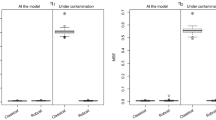Abstract
We propose a method to do constrained parameter estimation and inference from neuroimaging data using general linear model (GLM). Constrained approach precludes unrealistic hemodynamic response function (HRF) estimates to appear at the outcome of the GLM analysis. The permissible ranges of waveform parameters were determined from the study of a repertoire of plausible waveforms. These parameter intervals played the role of prior distributions in the subsequent Bayesian analysis of the GLM, and Gibbs sampling was used to derive posterior distributions. The method was applied to artificial null data and near infrared spectroscopy (NIRS) data. The results show that constraining the GLM eliminates unrealistic HRF waveforms and decreases false activations, without affecting the inference for “realistic” activations, which satisfy the constraints.







Similar content being viewed by others
References
Akin A, Bilensoy D, Emir UEE, Gülsoy M, Candansayar S, Bolay H (2006) Cerebrovascular dynamics in patients with migraine: near-infrared spectroscopy study. Neurosci Lett 400:86–91
Akgül CB, Akin A, Sankur B (2006) Extraction of cognitive activity-related waveforms from functional near-infrared spectroscopy signals. Med Biol Eng Comput 44:945–958
Buxton R, Wong E, Frank L (1998) Dynamics of blood flow and oxygenation changes during brain activation: the balloon model. Magn Reson Med 39:855–864
Buxton RB, Uludağ K, Dubowitz DJ, Lin TT (2004) Modeling the hemodynamic response to brain activation. Neuroimage 23:S220–S233
Cope M, Delpy DT (1998) A system for the long-term measurement of cerebral blood and tissue oxygenation in newborn infants by near infra-red transillumination. Med Biol Eng Comput 26:289–294
Devroye L (1986) Non-uniform random variate generation. Springer, New York
De Zwart JA, Silva AC, Van Gelterenn P, Kellman P, Fukunaga M, Chu R, Koretsky AP, Frank JA, Duyn JH (2005) Temporal dynamics of the BOLD fMRI impulse response. Neuroimage 24:667–677
Dunson DB, Neelon B (2003) Bayesian inference on order-constrained parameters in generalized linear models. Biometrics 59:286–295
Ehlis AC, Herrmann MJ, Wagener A, Fallgatter AJ (2005) Multi-channel near-infrared spectroscopy detects specific inferior-frontal activation during incongruent Stroop trials. Biol Psychol 69:315–332
Fabbri F, Sassaroli A, Henry ME, Fantini S (2004) Optical measurements of absorption changes in two-layered diffusive media. Phys Med Biol 49:1183–1201
Firbank M, Okada E, Delpy DT (1998) A theoretical study of the signal contribution of regions of the adult head to near-infrared spectroscopy studies of visual evoked responses. Neuroimage 8:69–78
Friman O, Borga M, Lundberg P, Knutsson H (2003) Adaptive analysis of fMRI data. Neuroimage 19:837–845
Friston KJ, Fletcher P, Josephs O, Holmes A, Rugg MD, Turner R (1998) Event-related fMRI:Characterizing differential responses. Neuroimage 7:30–40
Friston KJ, Josephs O, Zarahn E, Holmes AP, Rouquette S, Poline JB (2000) To smooth or not to smooth? Bias and efficiency in fMRI time-series analysis. NeuroImage 12:196–208
Gelfand AE, Smith AFM, Lee TM (1992) Analysis of constrained parameter and truncated data problems using sampling. J Am Stat Assoc 87:523–532
Gelman AB, Carlin JS, Stern HS, Rubin DB (1995) Bayesian data analysis. Chapman & Hall/CRC, Boca Raton
Handwerker DA, Ollringer JM, D’Esposito M (2004) Variation of BOLD hemodynamic responses across subjects and brain regions and their effect on statistical analyses. Neuroimage 21:1639–1651
Huppert TJ, Hoge RD, Diamond SG, Franceschinini MA, Boas DA (2006) A temporal comparison of BOLD, ASL, and NIRS hemodynamic responses to motor stimuli in adult humans. Neuroimage 29:368–382
MacLeod C (1991) Half a century of research on the stroop effect: an integrative review. Psychol Bull 109:163–203
Purdon PL, Weisskoff RM (1998) Effect of temporal autocorrelation due to physiological noise and stimulus paradigm on voxel-level false-positive rates in fMRI. Human Brain Mapp 6:239–249
Schroeter ML, Zysset S, Wahl M, von Cramon DY (2004) Prefrontal activation due to Stroop interference increases during development –an event-related fNIRS study. Neuroimage 23:1317–1325
Smith AFM, Roberts GO (1993) Bayesian computation via the Gibbs sampler and related Markov Chain Monte Carlo methods. J R Stat Soc Ser B (Methodological) 55:3–23
Smith AT, Singh KD, Balsters JH (2007) A comment on the severity of the effect of non-white noise in fMRI time-series. Neuroimage 36:282–288
Steinbrink J, Villringer A, Kempf F, Haux D, Boden S, Obrig H (2006) Illuminating the BOLD signal: combined fMRI-fNIRS studies. Magn Reson Imaging 24:495–505
Suzuki M, Miyai I, Ono T, Kubota K (2008) Activities in the frontal cortex and gait performance are modulated by preparation. An fNIRS study. Neuroimage 39:600–607
Villringer A, Chance B (1997) Non-invasive optical spectroscopy and imaging of human brain function. Trends Neurosci 20:4435–4442
Woolrich MW, Behrens TEJ, Smith SM (2004) Constrained linear basis sets for HRF modeling using Variational Bayes. Neuroimage 21:1748–1761
Woolrich MW, Ripley BD, Brady M, Smith SM (2001) Temporal autocorrelation in univariate linear modeling of fMRI data. Neuroimage 14:1370–1386
Worsley KJ, Taylor JE (2006) Detecting fMRI activation allowing for unknown latency of the hemodynamic response. Neuroimage 29:649–654
Zysset S, Muller K, Lohmann G, von Cramon DY (2001) Color–word matching Stroop task: separating interference and response conflict. Neuroimage 13:29–36
Author information
Authors and Affiliations
Corresponding author
Rights and permissions
About this article
Cite this article
Çiftçi, K., Sankur, B., Kahya, Y.P. et al. Constraining the general linear model for sensible hemodynamic response function waveforms. Med Biol Eng Comput 46, 779–787 (2008). https://doi.org/10.1007/s11517-008-0347-6
Received:
Accepted:
Published:
Issue Date:
DOI: https://doi.org/10.1007/s11517-008-0347-6




